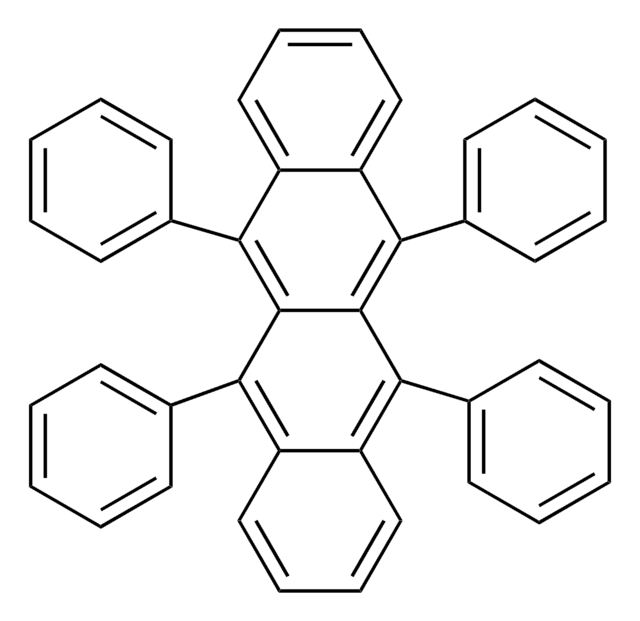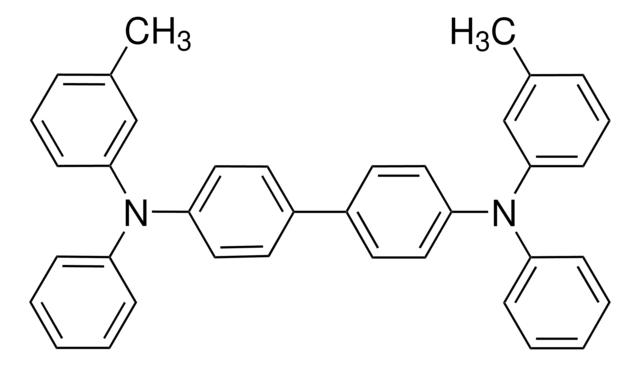Kluczowe dokumenty
753939
DBP
98% (HPLC)
Synonim(y):
5,10,15,20-Tetraphenylbisbenz[5,6]indeno[1,2,3-cd:1′,2′,3′-lm]perylene, Dibenzo{[f,f′]-4,4′,7,7′-tetraphenyl}diindeno[1,2,3-cd:1′,2′,3′-lm]perylene, Red 2
About This Item
Polecane produkty
Poziom jakości
Próba
98% (HPLC)
Formularz
solid
strata
0.5 wt. %, 373 °C
mp
>400 °C
Energia orbitalna
HOMO 5.5 eV (CV)
LUMO 3.5 eV (CV)
Wydajność urządzenia OPV
ITO/DBP/C60/BCP/Al
ciąg SMILES
c1ccc(cc1)-c2c-3c(-c4ccc5c6ccc7-c8c(-c9ccc(c%10ccc-3c4c5%10)c6c79)c(-c%11ccccc%11)c%12ccccc%12c8-c%13ccccc%13)c(-c%14ccccc%14)c%15ccccc2%15
InChI
1S/C64H36/c1-5-17-37(18-6-1)53-41-25-13-14-26-42(41)54(38-19-7-2-8-20-38)62-50-34-30-46-48-32-36-52-60-51(35-31-47(58(48)60)45-29-33-49(61(53)62)59(50)57(45)46)63-55(39-21-9-3-10-22-39)43-27-15-16-28-44(43)56(64(52)63)40-23-11-4-12-24-40/h1-36H
Klucz InChI
WPPDXAHGCGPUPK-UHFFFAOYSA-N
Szukasz podobnych produktów? Odwiedź Przewodnik dotyczący porównywania produktów
Kod klasy składowania
11 - Combustible Solids
Klasa zagrożenia wodnego (WGK)
WGK 3
Temperatura zapłonu (°F)
Not applicable
Temperatura zapłonu (°C)
Not applicable
Wybierz jedną z najnowszych wersji:
Certyfikaty analizy (CoA)
Nie widzisz odpowiedniej wersji?
Jeśli potrzebujesz konkretnej wersji, możesz wyszukać konkretny certyfikat według numeru partii lub serii.
Masz już ten produkt?
Dokumenty związane z niedawno zakupionymi produktami zostały zamieszczone w Bibliotece dokumentów.
Klienci oglądali również te produkty
Produkty
Materials Design Concepts for Efficient Blue OLEDs: A Joint Theoretical and Experimental Study
Fabrication procedure of organic field effect transistor device using a soluble pentacene precursor.
There is widespread demand for thin, lightweight, and flexible electronic devices such as displays, sensors, actuators, and radio-frequency identification tags (RFIDs). Flexibility is necessary for scalability, portability, and mechanical robustness.
Nasz zespół naukowców ma doświadczenie we wszystkich obszarach badań, w tym w naukach przyrodniczych, materiałoznawstwie, syntezie chemicznej, chromatografii, analityce i wielu innych dziedzinach.
Skontaktuj się z zespołem ds. pomocy technicznej







![Poly[2-methoxy-5-(2-ethylhexyloxy)-1,4-phenylenevinylene] average Mn 40,000-70,000](/deepweb/assets/sigmaaldrich/product/structures/344/488/b8f8179d-3970-4deb-a754-adda88cdb36f/640/b8f8179d-3970-4deb-a754-adda88cdb36f.png)